-
Engine2.5L I4
-
Power169 HP / 171 LB-FT
-
Transmission6-Speed Automatic
-
DrivetrainFront-Wheel Drive
-
Engine PlacementFront
-
Curb Weight3,979 LBS
-
Towing2,000 LBS (est)
-
Seating2+3+2
-
Cargo104.2 CU-FT (max)
-
MPG20 City / 28 HWY
-
Base Price$24,710
-
As Tested Price$32,145
The last time I tested a Ford Transit Connect, I needed to drive a group of friends to Boyne, MI, for a long weekend of skiing, snowboarding, and shenanigans. At roughly three hours, the trip is just long enough that my friends asked for something comfortable. A Range Rover would've been ideal. Perhaps a Mercedes-Benz GL or Cadillac Escalade. But no, I chose Transit Connect, to put Ford's small van formula to the test.
The tiny van was near the end of its lifecycle in 2012, having debuted in Europe in 2003. Its age was reflected in its loud, underpowered, inefficient engine; noisy, harsh ride; and uncomfortable seats. It was so uncomfortable that we had to stop every hour just to stretch our legs.
I didn't have such elaborate plans when this 2015 Transit Connect Wagon arrived in my driveway. But after a week behind the wheel, I can tell that road tripping in this van would be a far, far better experience.

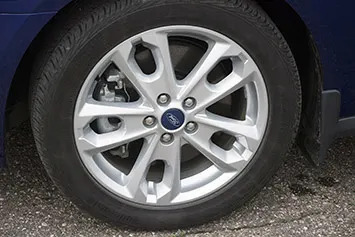
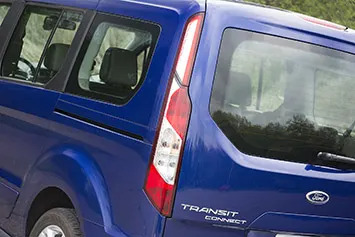
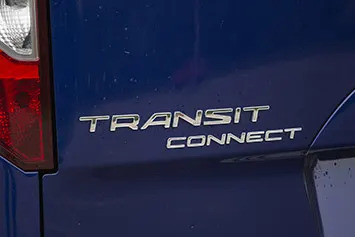
The most obvious change for the second-generation model is the styling. It's much better looking than the old TC, looking like the high-roofed spawn of a Focus and Escape. There are a few anomalies, though. First, note the word "Wagon" – that implies passenger van, while the cargo/work-minded Transit Connect is called "Van." Next, this Titanium model is only available on the longer-wheelbase, three-row Wagon. With the LWB configuration, the only tailgate option is a single-piece, lift-up hatch. If you want barn-style doors, get cozy with the short-wheelbase, two-row Transit Connect XLT. Regardless of body style, the Transit Connect Wagon's best styling feature is its enormous greenhouse that guarantees excellent visibility from any angle.
The interior adopts a dash layout similar to the Focus. The heated leather seats – standard on the Titanium – are nice enough, but better still is that the chairs are actually comfortable now. The plastics on the dash and doors are still hard and scratchy, but fit and finish is solid. And with major contact points and switchgear that have been pilfered from other Ford products, including the steering wheel, the occasional bad bits in the cabin are easy enough to ignore.
With room for three folks in the second row and two more in the back, the Transit Connect Wagon fills a role that is more utilitarian and spartan, but not much less versatile than traditional minivans. The middle row seats feature stadium-style raised seating, and both rows can slide forward and back or fold. The third row is best described as cozy and isn't particularly easy to access. But thanks to the TCW's shape, headroom is ample in all three rows.

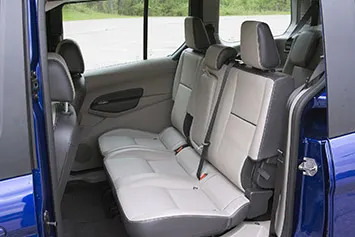


Flatten the second and third rows and the Wagon boasts a maximum of 104.2 cubic feet of cargo space. Folding only the third row still means there's an ample 58.9 cubic feet of storage on hand. The middle row can also be stowed into the floor, for additional vertical space.
In Ford's other vehicles, EcoBoost engines are widely available as a premium option, but in the Transit Connect Wagon, only the short-wheelbase model can be optioned with the 1.6-liter, turbocharged four-cylinder. LWB customers are stuck with a weaker, 2.5-liter four-cylinder Duratec engine that produces 169 horsepower and 171 pound-feet of torque – a loss of 9 hp and 13 lb-ft compared to the 1.6-liter EcoBoost. Accessing that power requires more revs, too, with peak torque arriving at 4,500 rpm compared to the EcoBoost's 2,500-rpm sweet spot.
We aren't damning the 2.5-liter, though. The Duratec engine has been on sale for some time and it's easy to understand why it's still so widely used throughout the Ford range. It's a pleasant companion that's willing to rev and sounds smooth. Still, performance is lacking in the nearly 4,000-pound LWB Wagon. At least the throttle is smooth, linear, and easy to modulate.
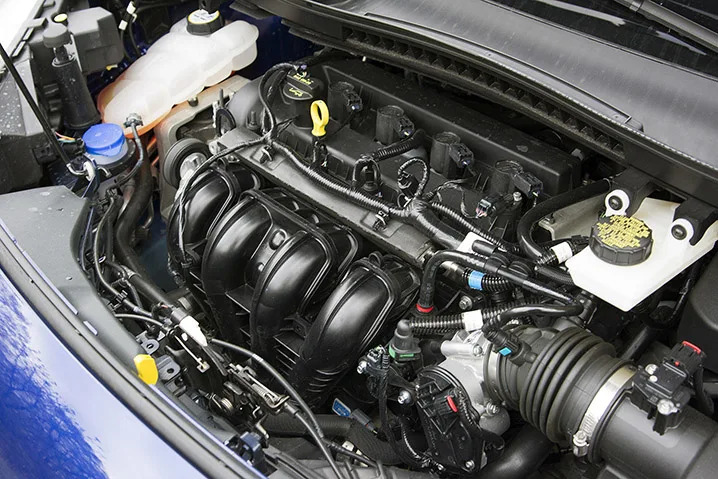
As a large four-cylinder, the 2.5-liter is still not hugely efficient. EPA ratings say this Titanium Wagon will return a meager 20 miles per gallon in the city and 28 mpg on the highway, compared to the EcoBoost's (still disappointing) 22 city and 30 highway. During my week of testing, I saw around 23 mpg.
One of the things that made the last-generation Transit Connect so unbearable on the freeway was its antiquated four-speed automatic, a transmission that thoroughly hated freeway driving. The 'new' 6F35 six-speed automatic is nearly as old as the engine it's paired with, having debuted in 2006 as the result of a 2002 partnership between Ford and General Motors. But it's far better than that old four-speed. Performance is relaxed on upshifts and downshifts, and it's unobtrusive at highway speeds.
Ford ditched the leaf-spring rear suspension of the last-generation Transit Connect and instead fitted a torsion-beam setup. The primary ride is fine, with the TCW managing the bigger imperfections well. But the van isn't as comfortable when faced with smaller, more frequent disruptions. It is, however, stable and composed at speed, behaving far better on the freeway than its predecessor. That said, road noise was a regular issue, despite the additional sound deadening fitted to the new van. It's not so much tire roar from the Continental tires, as suspension noises that disrupt daily driving, with both big and small impacts making their presence known.
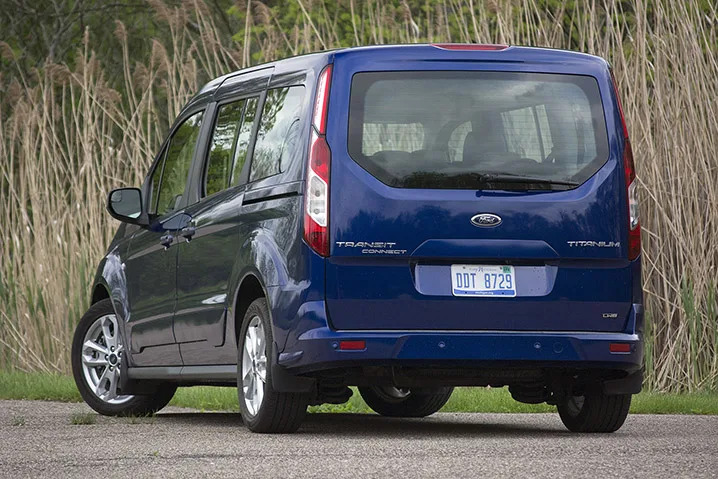
Where the Transit really shows its stripes is when you start driving it with verve. It's surprisingly agile, offering sharper turn-in than just about any other van not named Mazda5. Moreover, as you negotiate bends, the TCW's Focus underpinnings really shine. It doesn't roll too much, and offers a modicum of feedback through the chassis. The electric power-assisted steering is good, offering natural-feeling weight from lock to lock and exhibiting precise, enjoyable behavior regardless of speed. The Transit Connect Wagon is easily a more enjoyable steer than any of the heftier, more traditional minivans available today. Of course, with the Ford, you lose out on all the added comfort and interior goodies found in the more family-friendly vans.
Prices for the Transit Connect Wagon start at $24,710 for the base XLT which is the only short-wheelbase model on offer. The LWB-only XL starts at $25,185, while getting a Titanium model, like this test car, demands $29,185. For that coin, you're getting standard heated leather seats, Sync, a rear-view camera, and dual-zone climate control. Add MyFord Touch ($840), an overhead storage console ($95), 17-inch wheels ($420), front and rear parking sensors ($495), and a heated windshield ($300), and the total, as-tested price is $32,145, including $900 for destination.
After an extensive test of the last-generation model, the Transit Connect left me feeling cold. It was too loud, too slow, and too uncomfortable to be competitive. The second-generation TCW is a more fully realized concept that improves on its predecessor in quite literally every way. Ultimately, it's not going to be as comfortable as a more traditional minivan, but it makes up for those shortcomings by offering a more agile, entertaining, and affordable character that utility-minded shoppers would be wise to consider.
The tiny van was near the end of its lifecycle in 2012, having debuted in Europe in 2003. Its age was reflected in its loud, underpowered, inefficient engine; noisy, harsh ride; and uncomfortable seats. It was so uncomfortable that we had to stop every hour just to stretch our legs.
I didn't have such elaborate plans when this 2015 Transit Connect Wagon arrived in my driveway. But after a week behind the wheel, I can tell that road tripping in this van would be a far, far better experience.




The most obvious change for the second-generation model is the styling. It's much better looking than the old TC, looking like the high-roofed spawn of a Focus and Escape. There are a few anomalies, though. First, note the word "Wagon" – that implies passenger van, while the cargo/work-minded Transit Connect is called "Van." Next, this Titanium model is only available on the longer-wheelbase, three-row Wagon. With the LWB configuration, the only tailgate option is a single-piece, lift-up hatch. If you want barn-style doors, get cozy with the short-wheelbase, two-row Transit Connect XLT. Regardless of body style, the Transit Connect Wagon's best styling feature is its enormous greenhouse that guarantees excellent visibility from any angle.
The interior adopts a dash layout similar to the Focus. The heated leather seats – standard on the Titanium – are nice enough, but better still is that the chairs are actually comfortable now. The plastics on the dash and doors are still hard and scratchy, but fit and finish is solid. And with major contact points and switchgear that have been pilfered from other Ford products, including the steering wheel, the occasional bad bits in the cabin are easy enough to ignore.
With room for three folks in the second row and two more in the back, the Transit Connect Wagon fills a role that is more utilitarian and spartan, but not much less versatile than traditional minivans. The middle row seats feature stadium-style raised seating, and both rows can slide forward and back or fold. The third row is best described as cozy and isn't particularly easy to access. But thanks to the TCW's shape, headroom is ample in all three rows.




Flatten the second and third rows and the Wagon boasts a maximum of 104.2 cubic feet of cargo space. Folding only the third row still means there's an ample 58.9 cubic feet of storage on hand. The middle row can also be stowed into the floor, for additional vertical space.
In Ford's other vehicles, EcoBoost engines are widely available as a premium option, but in the Transit Connect Wagon, only the short-wheelbase model can be optioned with the 1.6-liter, turbocharged four-cylinder. LWB customers are stuck with a weaker, 2.5-liter four-cylinder Duratec engine that produces 169 horsepower and 171 pound-feet of torque – a loss of 9 hp and 13 lb-ft compared to the 1.6-liter EcoBoost. Accessing that power requires more revs, too, with peak torque arriving at 4,500 rpm compared to the EcoBoost's 2,500-rpm sweet spot.
We aren't damning the 2.5-liter, though. The Duratec engine has been on sale for some time and it's easy to understand why it's still so widely used throughout the Ford range. It's a pleasant companion that's willing to rev and sounds smooth. Still, performance is lacking in the nearly 4,000-pound LWB Wagon. At least the throttle is smooth, linear, and easy to modulate.

As a large four-cylinder, the 2.5-liter is still not hugely efficient. EPA ratings say this Titanium Wagon will return a meager 20 miles per gallon in the city and 28 mpg on the highway, compared to the EcoBoost's (still disappointing) 22 city and 30 highway. During my week of testing, I saw around 23 mpg.
One of the things that made the last-generation Transit Connect so unbearable on the freeway was its antiquated four-speed automatic, a transmission that thoroughly hated freeway driving. The 'new' 6F35 six-speed automatic is nearly as old as the engine it's paired with, having debuted in 2006 as the result of a 2002 partnership between Ford and General Motors. But it's far better than that old four-speed. Performance is relaxed on upshifts and downshifts, and it's unobtrusive at highway speeds.
Ford ditched the leaf-spring rear suspension of the last-generation Transit Connect and instead fitted a torsion-beam setup. The primary ride is fine, with the TCW managing the bigger imperfections well. But the van isn't as comfortable when faced with smaller, more frequent disruptions. It is, however, stable and composed at speed, behaving far better on the freeway than its predecessor. That said, road noise was a regular issue, despite the additional sound deadening fitted to the new van. It's not so much tire roar from the Continental tires, as suspension noises that disrupt daily driving, with both big and small impacts making their presence known.

Where the Transit really shows its stripes is when you start driving it with verve. It's surprisingly agile, offering sharper turn-in than just about any other van not named Mazda5. Moreover, as you negotiate bends, the TCW's Focus underpinnings really shine. It doesn't roll too much, and offers a modicum of feedback through the chassis. The electric power-assisted steering is good, offering natural-feeling weight from lock to lock and exhibiting precise, enjoyable behavior regardless of speed. The Transit Connect Wagon is easily a more enjoyable steer than any of the heftier, more traditional minivans available today. Of course, with the Ford, you lose out on all the added comfort and interior goodies found in the more family-friendly vans.
Prices for the Transit Connect Wagon start at $24,710 for the base XLT which is the only short-wheelbase model on offer. The LWB-only XL starts at $25,185, while getting a Titanium model, like this test car, demands $29,185. For that coin, you're getting standard heated leather seats, Sync, a rear-view camera, and dual-zone climate control. Add MyFord Touch ($840), an overhead storage console ($95), 17-inch wheels ($420), front and rear parking sensors ($495), and a heated windshield ($300), and the total, as-tested price is $32,145, including $900 for destination.
After an extensive test of the last-generation model, the Transit Connect left me feeling cold. It was too loud, too slow, and too uncomfortable to be competitive. The second-generation TCW is a more fully realized concept that improves on its predecessor in quite literally every way. Ultimately, it's not going to be as comfortable as a more traditional minivan, but it makes up for those shortcomings by offering a more agile, entertaining, and affordable character that utility-minded shoppers would be wise to consider.










Sign in to post
Please sign in to leave a comment.
Continue